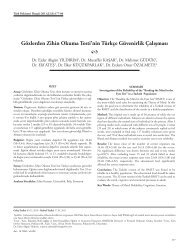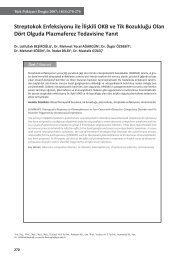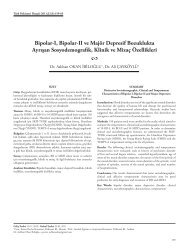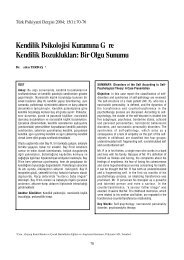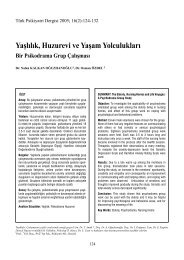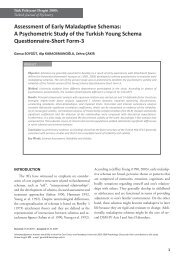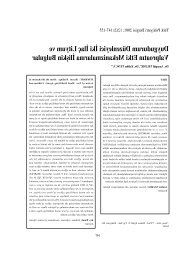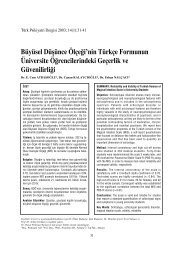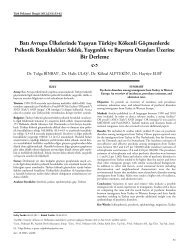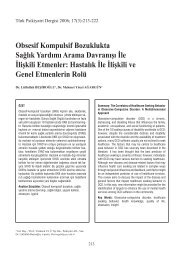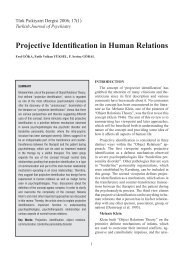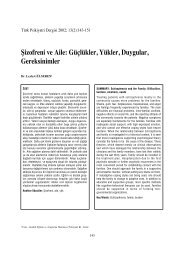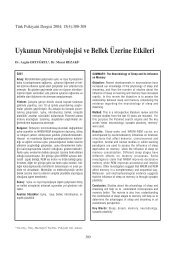0702_prevalence.tp fak.indd - Türk Psikiyatri Dergisi
0702_prevalence.tp fak.indd - Türk Psikiyatri Dergisi
0702_prevalence.tp fak.indd - Türk Psikiyatri Dergisi
You also want an ePaper? Increase the reach of your titles
YUMPU automatically turns print PDFs into web optimized ePapers that Google loves.
<strong>Türk</strong> <strong>Psikiyatri</strong> <strong>Dergisi</strong> 2007; 18(2)<br />
Turkish Journal of Psychiatry<br />
Prevalence of Depressive Symptoms, Ways of Coping, and<br />
Related Factors Among Medical School and Health Services<br />
Higher Educa on Students<br />
Mine KAYA, Metin GENÇ, Burhanettin KAYA, Erkan PEHLİVAN<br />
Abstract<br />
Objective: The aims of this study were to explore the <strong>prevalence</strong> of depressive symptoms, ways of coping, and<br />
their relationships to sociodemographic variables among students of the Medical Faculty (MF) and the Health<br />
Services Higher Education School (HSHES) at Inönü University.<br />
Method: The Beck Depression Inventory (BDI), Styles of Coping Inventory (SCI), and a sociodemographic<br />
questionnaire were used.<br />
Results: Among the HSHES students (n= 128), the <strong>prevalence</strong> of depressive symptoms was higher. The MF students<br />
whose fathers had a higher level of education had higher BDI scores. The MF students from families with lower<br />
levels of income had a higher frequency of depressive symptoms. In both groups, the students with previous<br />
histories of psychiatric and physical ilness had higher BDI scores. Among the MF students, older age (OR= 2.72),<br />
and among the HSHES students, having a previous history of psychiatric disorder (OR= 5.25) and female gender<br />
(OR= 1.85) affected the <strong>prevalence</strong> of depressive symptoms. The HSHES students used passive styles of coping<br />
more frequently. Active coping styles were used more frequently by the male students in both groups. The HSHES<br />
students whose mothers had lower levels of education, had higher passive coping style scores; active coping styles<br />
and higher family income correlated positively. In both groups, BDI and active styles scores correlated positively.<br />
Passive styles were used more frequently by male and female students that had a higher frequency of depressive<br />
symptoms.<br />
Conclusion: The rate of mental health problems was quite high among the students. Preventive mental health<br />
programs should be developed and implemented.<br />
Key Words: Depression, depressive symptoms, coping skills, medical students<br />
INTRODUCTION<br />
Mental health problems are a major public health<br />
problem due to their high <strong>prevalence</strong> rates, difficulties<br />
related with the treatement, and their tendencies to become<br />
chronic (Doğan et al., 1995; Güleç, 1997; WHO,<br />
2001). According to a study conducted in 14 countries<br />
by the World Health Organization (WHO), the most<br />
frequently seen disorder among patients who present to<br />
primary health care facilities is depression (10.4%).. In<br />
the Ankara-Gölbaşı data from the same study 17.6% of<br />
psychiatric diagnoses and 11.6% of depression diagnoses.<br />
were reported. In the Turkish Mental Health Profile<br />
study, which is the only study to have used nationwide<br />
data, depression and anxiety disorders were the most<br />
frequently seen psychiatric disorders (Erol et al., 1998).<br />
Mine Kaya, e-mail: kayamine70@yahoo.com<br />
Depression is second only to upper respiratory track disorders<br />
in rate of <strong>prevalence</strong> and is a major public health<br />
problem (Öztürk, 2001; Sartorius et al., 1993).<br />
Young adulthood is characterized as an identityforming<br />
period in which individuals experience social<br />
and physical changes, as well as various conflicts in emotional,<br />
behavioral, sexual, economic, academic, and social<br />
areas. The mental health of young adult university<br />
students is one of the most important components of<br />
public health (Bayhan, 2003; Doğan et al., 1994; Özkürkçügil-Çorapçıoğlu,<br />
1999). For these students, such<br />
factors as being female, age, and living away from the<br />
family were reported to be factors that increase psychiatric<br />
presentations (O’Neil et al., 1984). The most frequent<br />
reason for psychiatric presentation (62%) among univer-<br />
1
sity students is depressive-based problems (Surtees et al.,<br />
1998; Evans, 1999). Depression in youngsters is one of<br />
the most frequently encountered mental disorders and it<br />
leads to severe impairment in psychosocial and academic<br />
domains. Depression in youngsters present with similar<br />
symptoms as in adults, or can be masked by antisocial<br />
behaviors or learning difficulties (Canat, 1997).<br />
Epidemiological studies report that the <strong>prevalence</strong><br />
of depression in adolescents is 0.4%-8.3% and the lifetime<br />
<strong>prevalence</strong> is 15%-20% (Canat, 1997; Muris et al.,<br />
2001). Kandel and Davies (1986) reported that adolescents<br />
experience more depressive feelings than adults. In<br />
the same study depressive affect was more frequent in<br />
females than in males.<br />
Depression is fifth among the top illnesses that lead<br />
to global illness burden (Bruntland, 2000). Studies related<br />
to depression report a very wide range of <strong>prevalence</strong><br />
(9%-25%). Depression is 2 times more frequent<br />
in adolescent girls and women than in adolescent boys<br />
and men (Öztürk, 2001). Depression can begin at any<br />
age; however, the mean age of onset is the mid 20’s. Recent<br />
epidemiological studies report earlier age of onset.<br />
(Köroğlu, 1997; Öztürk, 2001; Yüksel, 2001). According<br />
to the earliest studies of depression <strong>prevalence</strong> in Turkey,<br />
the point <strong>prevalence</strong> speed is approximately 10% (Güleç<br />
1997).<br />
The concept of stress involves both stimulus and behavior,<br />
and the interaction between them (Baltaş, 2000).<br />
Stress is an adaptive behavior affected by individual differences<br />
and/or psychological processes, and appears as a<br />
result of any psychological behavior or event that causes<br />
severe stress on an individual (Artan, 1986). We can say<br />
that the basis of stress is an individual’s perception and<br />
evaluation of events, and that individual understanding<br />
and response results in an increase or decrease of stress<br />
(Cüceloğlu, 1996). In this regard, we can posit that<br />
engaging in protective health behavior is related to the<br />
development of ways of coping with stress. In a study<br />
by the United States Department of Public Health and<br />
Human Services (1990), it was stressed that half of all<br />
fatalities in the US are consequences of a lack of preventive<br />
health behavior (Baltaş, 2000; Beasley et al., 2003).<br />
Styles of coping with stress have a preventive role in<br />
mental health. Certain styles of coping with stress protect<br />
individuals from a stressful life style and some styles<br />
of coping increase the sensitivity of individuals towards<br />
mental problems (Muris et al., 2001).<br />
Using efficient and relevant ways of coping during<br />
adolescence results in the development of a healthy indi-<br />
2<br />
vidual, a healthy identity, and minimal behavioral problems<br />
and depressive symptoms. Relevant ways of coping<br />
with stress contribute a lot to the adjustment problems<br />
during these formative years (Steiner et al., 2002).<br />
The present study aimed to explore the <strong>prevalence</strong><br />
of depressive symptoms, ways of coping with stress,<br />
and their relationships with sociodemographic variables<br />
among students of the Medical Faculty (MF) and the<br />
Health Services Higher Education School (HSHES) at<br />
Inönü University.<br />
METHODS<br />
This cross sectional study was conducted with students<br />
from the MF and HSHES of Inönü University.<br />
Sample<br />
Of the 936 recruited students, 437 were MF students<br />
and 499 were HSHES students. All of the 936 students<br />
were included in the study, 182 declined participation,<br />
and the participation rate was 80.5% (n= 754).<br />
Data Collection Tools<br />
Sociodemographic Questionnaire<br />
This form developed by the researchers includes questions<br />
regarding age, sex, education, and working conditions<br />
of the parents, as well as family structure, residence<br />
(with the family or away from the family), place of birth<br />
(city or village), and past psychiatric or physiological illness.<br />
Socioeconomic status was determined according to<br />
the basic wage rate at the time of the study: basic wage<br />
rate and below (≤ 200 million TL/month) and above the<br />
basic wage rate (≥ 201 million TL/month).<br />
Beck Depression Inventory (BDI)<br />
One of the most frequently used self-report questionnaires<br />
used for research, the BDI is used to comprehensively<br />
detect depression symptoms. In addition, cognitive<br />
thought content is also evaluated (Sorias, 1997). In<br />
the Turkish adaptation study conducted with university<br />
students, a cut-off score of 17 was reported to correctly<br />
differentiate 90% of depression cases (Hisli, 1989).<br />
Styles of Coping Inventory (SCI)<br />
SCI was developed for university students based on<br />
the Ways of Coping Inventory developed by Folkman<br />
and Lazarus (1980). SCI is a brief inventory that measures<br />
ways of coping related to depression, loneliness, and<br />
psychosomatic problems, and is valid in different stress-
Table I. Demographic characteristics of the students<br />
MF<br />
(n= 352)<br />
ful conditions. With the aim of developing a scale that<br />
measures depression, various psychological symptoms,<br />
and loneliness, we compared the scores of this inventory<br />
in various end groups, which were categorized according<br />
to depression, psychological symptoms, and loneliness<br />
scores. Subsequently, 30 items that discriminated and<br />
related with various end groups developed according to<br />
the BDI, SCI, and UCLA (University of California at<br />
Los Angeles)-Loneliness Scale were chosen for the Brief<br />
SCI version (Şahin and Durak, 1995).<br />
The scale measures 2 main ways of coping with stress:<br />
problem oriented/active style and emotion oriented/passive<br />
style. Active styles are measured by the seeking of<br />
HSHES<br />
(n= 402)<br />
χ<br />
Sociodemographic characteristics<br />
2 P<br />
Number % Number %<br />
Gender<br />
Male 226 64.2 95 23.6 126.36 0.001<br />
Female<br />
Mothers’ education<br />
126 35.8 307 76.4<br />
Primary and below 218 61.9 331 82.3 39.47 0.001<br />
High school and above<br />
Fathers’ education<br />
134 38.1 71 17.7<br />
Primary and below 118 33.5 197 48.8 17.92 0.001<br />
High school and above<br />
Mothers’ employment<br />
234 66.5 205 51.2<br />
Unemployed 316 89.8 390 97.0 16.51 0.001<br />
Employed<br />
Fathers’ employment<br />
36 10.2 12 3.0<br />
Unemployed 117 33.2 166 41.3 5.19 0.023<br />
Employed 235 66.8 236 58.7<br />
Family Income<br />
Basic wage rate and below<br />
Above the basic wage rate<br />
Family Structure<br />
23<br />
275<br />
7.7<br />
92.3<br />
86<br />
254<br />
25.3<br />
74.7<br />
34.63 0.001<br />
Nuclear + Large family 316 89.8 376 93.5 3.51 0.061<br />
Divided family<br />
Residence<br />
36 10.2 26 6.4<br />
With the family 200 56.8 197 49.0 4.59 0.032<br />
Away from the family<br />
Place of birth<br />
152 43.2 205 51.0<br />
City 270 76.7 242 60.2 23.45 0.001<br />
Town or village<br />
Reported previous history of<br />
psychiatric illness<br />
82 23.3 160 39.8<br />
Yes 25 7.1 18 4.5 2.40 0.121<br />
No<br />
Reported previous history of any<br />
illness other than psychiatric illness<br />
327 92.9 384 95.5<br />
Yes 51 14.5 49 12.2 0.86 0.353<br />
No 301 85.5 353 87.8<br />
social support, optimistic style, and self-confident style<br />
subscales, whereas passive styles are measured by the<br />
helpless style and submissive style subscales. It was found<br />
that individuals who cope effectively with stress use the<br />
optimistic style and the self-confident style, while those<br />
who cannot cope effectively use the helpless style and the<br />
submissive style. High scores indicate a tendency for the<br />
particular style (Şahin and Durak, 1995).<br />
Procedure<br />
Questionnaires used in the study were administered<br />
in classrooms under the guidance of the researchers.<br />
Before the questionnaires were administered, informed<br />
3
Table II. Risk factors affecting the <strong>prevalence</strong> of depressive symptoms according to the logistic regression analysis<br />
Factors<br />
MF<br />
B SE Exp (B) P 95% CI<br />
Increase in age<br />
HSHES<br />
1.00 0.13 2.72 0.001 2.09-3.54<br />
Previous psychiatric history 1.65 0.63 5.25 0.009 1.50-18.27<br />
consent was received from all the participating students.<br />
Students were informed that they did not have<br />
to participate or provide their names, all their questions<br />
about the study would be answered, and the data would<br />
be used for scientific purposes. Students who accepted<br />
these conditions filled out the forms. The cut-off score<br />
for BDI was ≥ 17 (Ceylan et al., 2003; Karakaya et al.,<br />
2004; Bostancı et al., 2005; Güleç et al., 2005).<br />
Statistical Method<br />
All findings are presented as a mean and standard<br />
deviation. Mann-Whitney U tests and Spearman’s correlation<br />
analyses were performed with the data that did<br />
not fit into the normal distribution. Data in the normal<br />
distribution was analyzed with the t test and chi-square<br />
analysis was used for categorical data. The level of significance<br />
was P< 0.05. In evaluating the risk factors of the<br />
students for depression according to schools, backward<br />
logistic regression analysis was used.<br />
Variables that were found to be significant in the<br />
chi-square analysis were entered into the logistic regression<br />
model (significance level: P≤ 0.10) (Rothman and<br />
Greenlend, 1998).<br />
FINDINGS<br />
The mean age of the students was 21.5 ± 1.8 years.<br />
The distribution of the MF and HSHES students according<br />
to some sociodemographic variables are presented<br />
in Table I.<br />
Depressive symptoms<br />
The mean BDI score of the MF and HSHES students<br />
was 10.57 ± 7.95 and 13.47 ± 8.45, respectively.<br />
The BDI scores of HSHES students were significantly<br />
higher than those of the MF students (U = 54585.5, P =<br />
0.001). When evaluated according to the cut-off score,<br />
depressive symptoms were more prevalent in HSHES<br />
students (31.8%, n = 128) than in MF students (21.9%,<br />
n = 77) (χ2 = 8.91, P = 0.0003).<br />
The mean age of MF students with higher depressive<br />
4<br />
Female gender 0.61 0.30 1.85 0.040 0.95-2.14<br />
symptom levels was 24.07 ± 1.23 years, and the mean<br />
age of MF students with lower depressive symptom levels<br />
was 21.26 ± 1.76 (U = 2152.5, P = 0.001). There was<br />
no significant relationship between age and depressive<br />
symptomatology in both groups of students.<br />
While there was no difference between the education<br />
level of the mother and depressive symptomatology<br />
scores among MF students, BDI scores of those whose<br />
mothers had a high school or above education (9.50 ±<br />
7.88) were higher in comparison to the students with<br />
mothers whose education level was primary school or below<br />
(U= 11885.0, P = 0.033). When education level of<br />
the fathers was entered in to Spearman’s correlation with<br />
illiterate, literate, primary school graduate, high school<br />
graduate, lycee graduate, university, and graduate education<br />
intervals, it was found to be related to BDI scores<br />
(r = 0.117, P= 0.028). When evaluated according to the<br />
s<br />
cut-off score, the difference between depressive symptoms<br />
and education level of fathers was not significant.<br />
The mean BDI score of HSHES students whose parents<br />
were divorced had higher (17.73 ± 10.17) than the<br />
students from nuclear or large families (13.18 ± 8.2) (t<br />
= 2.67, P = 0.008). According to the BDI cut-off scores,<br />
depressive symptoms were prevalent in 50% of the students<br />
from divided families (χ2 = 4.22 P = 0.0040). There<br />
was no significant difference in MF students, according<br />
to family type.<br />
In the MF group, the BDI scores of the students<br />
from families with monthly income at or below the basic<br />
wage rate were higher than (15.39 ± 11.26) the students<br />
whose monthly family income was above the basic wage<br />
rate (t= 2.18, P= 0.039). Depressive symptoms were<br />
prevalent in 43.5% of the students from families with<br />
monthly income at or below the basic wage rate (Fisher’s<br />
test P= 0.014). There was no relationship between socioeconomic<br />
level of the family and depressive symptomatology<br />
in the HSHES group; however, when income of<br />
the family was used as a continuous variable, the BDI<br />
scores increased as income decreased (r = –0.126, P=<br />
s<br />
0.020). This was not the case for the MF group. There
Table III. Distribution of the students according to SCI subgroup medians<br />
SCI subgroups<br />
MF<br />
students<br />
HSHES<br />
students<br />
were no significant differences between living away from the<br />
family, the place of birth, and BDI scores.<br />
Both MF students (15.04 ± 10.93) and HSHES students<br />
(19.83 ± 9.48) with previous histories of psychiatric<br />
and physical disorders had higher BDI scores (MF: U =<br />
2974.5, P= 0.023; HSHES: U= 2034.0, P= 0.003). While<br />
there were no differences in the MF group according to the<br />
BDI cut-off score, the <strong>prevalence</strong> of depressive symptomatology<br />
in HSHES students with a previous psychiatric history<br />
was 61.1% (χ2 = 7.43, P = 0.006).<br />
The mean BDI score of the MF and HSHES students<br />
with a history of previous physical illness was 13.86 ± 10.88<br />
and 16.63 ± 9.98, respectively. Among both student groups,<br />
depression scores of the students with a history of previous<br />
physical illness were high (MF students; U = 6212.0, P =<br />
0.029; HSHES students; t = 2.41, P = 0.019). When evaluated<br />
according to the BDI cut-off score, there was no significant<br />
difference between the 2 student groups.<br />
For MF students, monthly family income (P= 0.014),<br />
previous psychiatric (P= 0.076) and physical illness (P =<br />
0.076), and age (P= 0.001) variables were entered in to a<br />
backward logistic regression model and having older age<br />
(OR= 2.72) was related to the <strong>prevalence</strong> of depressive<br />
symptoms.<br />
For HSHES students, monthly family income (P=<br />
0.053), previous psychiatric (P= 0.006) and physical illness<br />
(P= 0.077), sex (P= 0.068), and family structure (P = 0.040)<br />
variables were entered in to a backward logistic regression<br />
model and monthly family income (P= 0.014), previous<br />
psychiatric (P= 0.076) and physical illness (P= 0.076), a previous<br />
history of psychiatric disorder (OR= 5.25), and being<br />
female (OR= 1.85) were related to the <strong>prevalence</strong> of depressive<br />
symptoms.<br />
Ways of Coping with Stress<br />
According to the subscales of SCI, HSHES students<br />
U P<br />
SSS 1 7 (0-12) 8 (0-12) 68602.5 0.468<br />
OS 2 9 (0-15) 9 (0-15) 69612.5 0.701<br />
HS 3 9 (0-23) 11 (0-21) 58767.0 0.000<br />
SS 4 5 (0-16) 6 (0-18) 66039.5 0.112<br />
SCS 5 14 (0-21) 14 (0-21) 66595.5 0.162<br />
1. SSS: seeking social support, 2. OS: optimistic style, 3. HS: optimistic style, 4. SS: submissive style, 5. SCS: self-confident style<br />
used a helpless coping style more than MF students (U=<br />
58767.0, P = 0.001). The passive coping style mean score<br />
of the MF students was 14.86 ± 6.19, and for HSHES<br />
students it was 16.47 ± 6.84. HSHES students used passive<br />
styles more than the MF students (U= 59657.5, P=<br />
0.001). (Table III).<br />
In the MF group, male students used more active<br />
coping styles (t= 3.78, P= 0.001), whereas female students<br />
used more passive styles (U= 12004.0, P= 0.014).<br />
Among the HSHES group, male students used more active<br />
coping styles than females (t= 2.03, P= 0.043), but<br />
there were no gender differences in terms of using passive<br />
styles.<br />
Among the HSHES students, those whose mother’s<br />
education level was primary school and below used passive<br />
coping styles more (t= 2.10, P= 0.036). There were<br />
no significant relationships between the level of education<br />
of the father, parents’ working conditions, structure<br />
of the family, and living conditions, with using active<br />
and passive styles, among the students of both groups.<br />
There was a weak, positive correlation between family<br />
income and active coping style scores in the HSHES<br />
group; as family income increased, active styles also increased<br />
(r = 0.148, P= 0.006). There was no correlation<br />
s<br />
between family income and coping styles among the MF<br />
students.<br />
There was no significant difference between having<br />
a past psychiatric illness and using active or passive coping<br />
styles in the MF group. HSHES students with past<br />
psychiatric illnesses used active styles more. The active<br />
coping style mean score of the students with past psychiatric<br />
illnesses was 25.22 ± 6.63, while for students<br />
without a past psychiatric illnesses it was 30.20 ± 7.16<br />
(t= 2.89, P= 0.004). There was no significant difference<br />
between having a past physical illness and active and<br />
passive styles in both groups. In addition, as BDI scores<br />
5
Table IV. Correlations of BDI scores with active passive style scores.<br />
BDI<br />
increased, active style scores decreased and passive style<br />
scores increased (Table IV). In both groups, students with<br />
depressive symptomatologies used more passive coping<br />
styles and students without depressive symptomatologies<br />
used more active styles (P< 0.05) (Table V).<br />
DISCUSSION<br />
The frequency of depressive symptoms in adolescents<br />
is reported to be 21%-56% worldwide, , whereas in Turkey<br />
it is 27% (Öy, 1995). High depression scores in the<br />
HSHES students might indicate that these students experienced<br />
more anxiety about their futures and employment,<br />
and that they were less satisfied with their schools.<br />
In a study conducted at Texas University, BDI mean score<br />
of the students was 8.2 ± 2.9 (Penland et al., 2000). In another<br />
US study conducted with students between 17 and<br />
25 years of age, the BDI mean score was 7.6 (Oliver and<br />
Paul, 1995). BDI scores and the depression <strong>prevalence</strong> in<br />
our study were higher than the European and USA samples,<br />
except for the West European sample. The level of<br />
social and economic developmental factors might explain<br />
this.<br />
Higher depressive symptoms in older students in the<br />
MF sample are compatible with studies showing higher<br />
depression rates in adolescents than in adults. On the<br />
other hand, increased depressive symptoms in senior students<br />
reflect future and employment anxieties (Kandel<br />
and Davies, 1986). Age increase was shown to be a factor<br />
that increases admission to psychiatry clinics (O’Neil et<br />
al., 1984).<br />
Based on family income and education level, and place<br />
of birth and residence, it was observed that MF students<br />
were from higher socioeconomic and sociocultural classes.<br />
In a study conducted with university students in Sivas,<br />
Turkey using the BDI, the <strong>prevalence</strong> of depressive symptoms<br />
for medical faculty students was 35.2% and for nursing<br />
graduate school students it was 26%. The <strong>prevalence</strong><br />
in the total sample was 34.7% (Doğan et al., 1994).<br />
6<br />
MF HSHES<br />
Active styles –0.474* –0.352*<br />
Passive styles 0.409* 0.448*<br />
*P< 0.05<br />
In a study conducted using BDI in Denizli, Turkey<br />
among a sample of students from different faculties, the<br />
<strong>prevalence</strong> of depressive symptoms was 26.2% (Bostancı<br />
et al., 2005). The <strong>prevalence</strong> of depression found in a<br />
study conducted with the 13-item form of BDI in 15 European<br />
countries was 32% (Allgöwer et al., 2001). In the<br />
evaluation of 6463 university students from East and West<br />
Europe, the <strong>prevalence</strong> of depression in the East European<br />
sample was 3.2%, whereas in the West European sample<br />
it was 23.5% (Steptoe and Wardle, 2001).<br />
Depressive symptoms were more prevalent in the<br />
HSHES students whose parents were divorcced This finding<br />
could be an evidence for inadequate social support systems.<br />
In a study by Luecken (2000) loss of one parent in<br />
childhood was shown to be a risk factor for depression<br />
in adolescence and adulthood. Family unity is an important<br />
factor in the development and course of depression.<br />
Continuity of family unity serves as a protective factor<br />
for mental health (Toros and Bilgin, 2002). The general<br />
inadequate socioeconomic conditions of the HSHES students<br />
might have affected their development of depressive<br />
symptoms. It was reported that cumulative stress that<br />
occurs which is a result of accumulated minor stresses is<br />
more of a factor in the development of physical and mental<br />
disorders than stress due to major life events. Reactions<br />
to minor stressors were found to have a greater effect on<br />
depressive mood (Felsten, 2004).<br />
HSHES students with previous psychiatric histories<br />
used active coping styles more. As a psychiatric disorder<br />
can make an individual more sensitive to the effects of<br />
stress, it can also cause differences in the ways of coping<br />
with stress. Many studies have shown that cumulative<br />
stress has a greater effect than stress due to major life<br />
events in the development of physical and mental disorders<br />
(Felsten, 2004). The effect of cumulative stress on the<br />
adjustment mechanisms of individuals is different than<br />
the effects of stress from major life events.<br />
In the MF group, depression scores were higher among<br />
the students from families with monthly incomes at or below<br />
the basic wage. In a study conducted at Gülhane Military<br />
Medical Academy, Turkey, BDI scores of students of<br />
low socioeconomic class were significantly high (Bakır<br />
et al., 1997); however, in another study conducted with<br />
Pamukkale University students, there was no relationship<br />
between family economic status and the <strong>prevalence</strong> of depressive<br />
symptoms (Bostancı et al., 2005).<br />
In our study, when socioeconomic differences between<br />
the students were considered, a relationship was<br />
found between low-income level and depressive symp-
Table V. Distribution of genders and coping style scores according to the <strong>prevalence</strong> of depressive symptoms.<br />
SCI<br />
MF(X ± S)<br />
Male<br />
Yes<br />
Depressive symptoms<br />
No<br />
t p<br />
Active 25.04 ± 6.96 32.77 ± 6.05 7.49 0.000<br />
Passive<br />
Female<br />
18.71 ± 6.56 13.23 ± 5.99 5.42 0.000<br />
Active 24.09 ± 6.22 29.67 ± 6.39 4.24 0.000<br />
Passive<br />
HSHES (X ± S)<br />
Male<br />
17.58 ± 5.18 15.20 ± 5.51 2.11 0.036<br />
Active 27.52 ± 6.47 32.50 ± 6.50 3.20 0.002<br />
Passive<br />
Female<br />
20.17 ± 7.00 14.76 ± 7.05 3.20 0.002<br />
Active 26.52 ± 7.23 31.16 ± 6.81 5.54 0.000<br />
Passive 19.85 ± 6.03 14.91 ± 6.37 6.56 0.000<br />
toms; as income level decreased, the <strong>prevalence</strong> of depressive<br />
symptoms increased. It was shown that low socioeconomic<br />
status is related to poor mental and physical<br />
health (Belek, 1999). Socioeconomic differences, as an<br />
independent variable, may affect course of mental health<br />
by contributing to school and course adjustment, meeting<br />
educational expenses, healthy life conditions. Many<br />
studies report higher depressive symptomatology in low<br />
socioeconomic subjects (Bostancı et al., 2005; Ceylan et<br />
al., 2003; Lorant et al., 2003; Goodman et al., 2002;<br />
Goodman et al., 2003).<br />
In the MF students, it was found that as the education<br />
level of the father increased, depressive symptoms<br />
also increased. Higher expectations of the family might<br />
be the underlying reason.<br />
In both student groups, a previous history of psychiatric<br />
and physical illness increased depression scores, and<br />
a previous psychiatric history was a risk factor for depression<br />
only in the HSHES students. It is known that depression<br />
is frequent in individuals with physical illnesses<br />
and that mental disorders have a negative affect on the<br />
course of physical illness (Sağduyu et al., 2000).<br />
HSHES students used more passive styles of coping<br />
with stress. This was a result of using more helpless styles<br />
of coping. Using more passive styles might have been<br />
due to higher rates of depressive ssymptoms and having<br />
lower socioeconomic status than the MF students.<br />
In a study conducted with The Coping Inventory for<br />
Stressful Situations (CISS) in Tasmania, it was reported<br />
that there were no gender differences in using active and<br />
passive styles of coping (Beasley et al., 2003). In a study<br />
of 13-19-year-olds conducted by Muris et al. (2001),<br />
it was reported that female students used passive styles<br />
of coping more than males. In our study active styles<br />
of coping were more prevalent among male students in<br />
both schools.<br />
In both student groups, as BDI scores increased, passive<br />
style scores also increased. In a study conducted at<br />
Texas University it was reported that depressive students<br />
used more passive coping styles (Penland et al., 2000). In<br />
Muris et al.’s (2001) study, similar to adults, adolescent<br />
depression scores also displayed a negative correlation<br />
with active styles and a positive correlation with passive<br />
styles. Researchers have suggested that a negative style<br />
serves as fuel for depression. In a study conducted in<br />
Canada in which depressive patients, hospital staff, and<br />
university students were compared, passive styles were<br />
more prevalent among depressive patients (Ravindran et<br />
al., 2002). In a Korean study, it was reported that university<br />
students with higher depressive scores used more<br />
passive coping styles and as depression scores decreased,<br />
active coping style scores increased (Choi, 2003). It can<br />
also be hypothesized that as depressive symptomatology<br />
increased, passive styles of coping with helplessness increased,<br />
and individuals who use passive styles are more<br />
prone to depression.<br />
In a study conducted with women using CISS and<br />
BDI it was found that an emotion oriented coping style<br />
was positively correlated with depressive symptoms (Flett<br />
et al., 1996). In another study conducted with adolescents<br />
it was found that girls use passive styles more than<br />
boys and display more depressive symptoms (Hanninen<br />
and Aro, 1996). Boys in comparison to girls seem to be<br />
more socially advantageous in coping with stress. It can<br />
7
e said that higher levels of depressive symptoms is the<br />
most important factor that negatively affects coping with<br />
stress.<br />
Perceiving life events in a negative fashion leads to<br />
ineffective coping abilities (Ravindran et al., 2002). In<br />
turn, as a passive style of coping becomes the norm, active<br />
abilities are displayed less frequently. It was reported that<br />
negative cognitive evaluation fosters the development of<br />
psychiatric disorders. Individual differences in evaluating<br />
stress factors might result in developing different coping<br />
abilities (Hojat et al., 2003). The second most important<br />
point is the level and existence of social support systems.<br />
Social support is one of the most important factors for<br />
maintaining good health. Low levels of social support<br />
are related to poor health. Quality of life has a similar<br />
effect (Ravindran et al., 2002). It can be predicted that<br />
socioeconomic level differences would affect both social<br />
support systems and the relationship of the individual<br />
with the external world and therefore affect the information<br />
processing process and determine the quality of<br />
behaviors in coping with stress. Other studies also found<br />
a positive relationship between depressive symptoms and<br />
help-seeking behavior. Especially the predictive effect of<br />
female gender is stressed (Ravindran et al., 2002; Ayrancı<br />
and Yenilmez, 2002; Wilde et al., 2004).<br />
A mother’s education level is an important factor that<br />
affects a child’s level of coping with stress. The present<br />
study found that as the mothers’ education levels increased,<br />
using active, positive coping styles increased. In<br />
REFERENCES<br />
Allgöwer A, Wardle J, Steptoe A (2001) Depressive symptoms, social<br />
support, and personal health behaviours in young men and women. Health<br />
Psychol, 20(3):223-227.<br />
Artan İ (1986) Örgütsel Stres Kaynakları ve Yöneticiler Üzerinde Bir<br />
Uygulama. İstanbul, Özgül Matbaacılık.<br />
Ayrancı Ü, Yenilmez Ç (2002) Eskişehir ilinde birinci basamak sağlık<br />
kurumlarında verilen ruh sağlığı hizmetlerinin değerlendirilmesi. Turkish<br />
Psychiatry Journal, 13(2):115-124.<br />
Bakır B, Yılmaz R, Yavaş İ et al. (1997) MF öğrencilerinde sorun alanları<br />
ve sosyodemografik özelliklerle depresif belirtilerin karşılaştırılması.<br />
Düşünen Adam, 10(1):5-12.<br />
Baltaş Z (2000) Stres ve Sağlık. Sağlık Psikolojisi Halk Sağlığında<br />
Davranış Bilimleri. İstanbul, Remzi Kitabevi. s.133-170.<br />
Bayhan V (2003) Genç Kimliği: Üniversite Gençliğinin Sosyolojik<br />
Profili. Malatya, İnönü Üniversitesi Yayınları. s.27-41.<br />
Beasley M, Thompson T, Davidson J (2003) Resilience in response to<br />
life stress: the effects of coping style and cognitive hardiness. Pers Individ<br />
Dif, 34:77-95.<br />
Belek İ (1999) Sosyal sınıf, eğitim, gelir ve mahalle: Hangisi sağlığın<br />
en önemli belirleyenidir? Antalya’da bir araştırma. Sosyoloji Araştırmaları<br />
<strong>Dergisi</strong>, 2 (1-2):49-74.<br />
8<br />
another study conducted with medical faculty students<br />
it was reported that, as the educational level of mothers<br />
increased, the frequency of submissive behavior also<br />
decreased (Kaya et al., 2004). In our study there was no<br />
such relationship for the MF students.<br />
The relationship between family income level and<br />
ways of coping with stress in HSHES students was important<br />
in terms of demonstrating the effect of socioeconomic<br />
variables on the level of coping with stress.<br />
In conclusion, the <strong>prevalence</strong> of depressive symptoms<br />
and mental health problems among both groups<br />
of students were high. Therefore, in epidemiological<br />
studies of university students, socioeconomic variables<br />
should be evaluated more carefully and comprehensively.<br />
School-based health programs should be developed. The<br />
functions of medico-social centers that provide health<br />
services to students should be reviewed and reorganized.<br />
Programs in these centers should include preventive and<br />
protective approaches. When the characteristics of students<br />
who present to psychiatry clinics are considered,<br />
protective approaches should be developed, especially for<br />
groups at risk (female, students living away from their<br />
families, and students of low socioeconomic status). In<br />
addition to the development of preventive and protective<br />
training environments for children and adolescents,<br />
there is a need for both school-based counseling services<br />
and relationship opportunities that are therapeutic and<br />
aim to develop certain abilities.<br />
Bostancı M, Özdel O, Oğuzhanoğlu NK et al. (2005) Depressive<br />
symptomatology among university students in Denizli, Turkey: Prevalence<br />
and sociodemographic correlates. Croat Med J, 46(1):96-100.<br />
Bruntland GH (2000) Mental Health in the 21st century. Bull World<br />
Health Organ, 78(4):411.<br />
Canat S (1997) Ergenlerde depresyon. Ergenlikte Ruhsal Sorunlara<br />
Yaklaşım-II, Ege <strong>Psikiyatri</strong> Sürekli Yayınları, 2(4):469-472.<br />
Ceylan A, Özen Ş, Palancı Y et al. (2003) Lise son sınıf öğrencilerinde<br />
anksiyete-depresyon düzeyleri ve zararlı alışkanlıklar: Mardin çalışması.<br />
Anadolu <strong>Psikiyatri</strong> <strong>Dergisi</strong>, 4:144-150.<br />
Choi MK (2003) Symptoms, depression, and coping behaviors of<br />
university students (abstract). Taehan Kanho Hakhoe Chi, 33(3):433-439.<br />
Cüceloğlu D (1996) İnsan ve Davranışı: Psikolojinin Temel<br />
Kavramları. 6. Basım, İstanbul, Remzi Kitabevi. s.325.<br />
Doğan O, Doğan S, Çorapçıoğlu A et al. (1994) Üniversite<br />
öğrencilerinde depresyon yaygınlığı ve bazı değişkenlerle ilişkisi. C.Ü. Tıp<br />
Fak. <strong>Dergisi</strong>, 16(2):148-151.<br />
Doğan O, Gülmez H, Ketenoğlu C et al. (1995) Ruhsal Bozuklukların<br />
Epidemiyolojisi. Sivas, Dilek Matbaası.<br />
Erol N, Kılıç C, Ulusoy M et al. (1998) <strong>Türk</strong>iye Ruh Sağlığı Profili<br />
Raporu. Ankara, T.C. Sağlık Bakanlığı Temel Sağlık Hizmetleri Genel<br />
Müdürlüğü.
Evans SW (1999) Mental Health Services in schools: Utilization,<br />
effectiveness, and consent. Clin Psychol Rev, 19(2):165-178.<br />
Felsten G (2004) Stress reactivity and vulnerability to depressed mood<br />
in college students. Pers Individ Dif, 36:789–800.<br />
Flett GL, Blankstein KR, Obertynski M (1996) Affect intensity,<br />
coping styles, mood regulation expectancies, and depressive symptoms.<br />
Pers Individ Dif, 20(2):221-228.<br />
Folkman S, Lazarus RS (1980) An analysis of coping in a middle-aged<br />
community sample. J Health Soc Behav, 21:219-239.<br />
Goodman E, Huang B (2002) Socioeconomic status, depressive<br />
symptoms, and adolescent substance use. Arch Pediatr Adolesc Med,<br />
156:448-453.<br />
Goodman E, Huang B, Wade TJ et al. (2003) A multilevel analysis of<br />
the relation of socioeconomic status to adolescent depressive symptoms:<br />
does school context matter? J Pediatr, 143:451-456.<br />
Güleç C (1997) Toplum Ruh Sağlığı Açısından <strong>Psikiyatri</strong>k<br />
Epidemiyoloji. Halk Sağlığı Temel Bilgiler. Ed: Bertan M, Güler Ç. 2.baskı,<br />
Ankara, Güneş Kitabevi. s.442-454.<br />
Güleç M, Bakır B, Özer M et al., (2005) Association between cigarette<br />
smoking and depressive symptoms among military medical students in<br />
Turkey. Psychiatry Res, 134:281-286.<br />
Hanninen V, Aro H (1996) Sex differences in coping and depression<br />
among young adults. Soc Sci Med, 43(10):1453-1460.<br />
Hisli NŞ (1989) Beck Depresyon Envanteri’nin üniversite öğrencileri<br />
için geçerliği, güvenirliği. Psychology Journal, 7(23):3-13.<br />
Hojat M, Gonnella JS, Erdmann JB et al.,(2003) Medical students’<br />
cognitive appraisal of stressful life events as related to personality, physical<br />
well-being, and academic performance: a longitudinal study. Pers Individ<br />
Dif, 35:219–235.<br />
Kandel DB, Davies M (1986) Adult sequale of adolescent depressive<br />
symptoms. Arch Gen Psychiatry, 43:255-262.<br />
Karakaya I, Ağaoğlu B, Coşkun A et al., (2004) Marmara Depreminden<br />
Üç Buçuk Yıl Sonra Ergenlerde TSSB, Depresyon ve Anksiyete Belirtileri.<br />
Turkish Psychiatry Journal, 15(4):257-263.<br />
Kaya M, Güneş G, Kaya B et al., (2004) Tıp Fakültesi öğrencilerinde<br />
boyun eğici davranışlar ve şiddetle ilişkisi. Anadolu <strong>Psikiyatri</strong> <strong>Dergisi</strong>, 5:5-<br />
10.<br />
Köroğlu E (1997) Majör Depresif Bozukluk. <strong>Psikiyatri</strong> Temel Kitabı,<br />
cilt 1, Ed: C. Güleç, E. Köroğlu, Ankara, Hekimler Yayın Birliği, s.389-<br />
421.<br />
Lorant V, Deliege D, Eaton W et al., (2003) Socioeconomic inequalities<br />
in depression: a meta-analysis. Am J Epidemiol, 157:98-112.<br />
Luecken LJ (2000) Attachment and loss experiences during childhood<br />
are associated with adult hostility, depression, and social support. J<br />
Psychosom Res, 49:85-91.<br />
Muris P, Schmidt H, Lambrichs R et al., (2001) Protective and<br />
vulnerability factors of depression in normal adolescents. Behav Res<br />
Ther, 39:555-565.<br />
Oliver JM, Paul JC (1995) Self-esteem and self-efficacy: perceived<br />
parenting and family climate and depression in university students. J Clin<br />
Psychol, 51(4):467-481.<br />
O’Neil MK, Lancee WJ, Freeman SJJ (1984) Help-seeking behaviour<br />
of depressed students. Soc Sci Med, 18(6):511-514.<br />
Öy B (1995) Çocuk ve ergenlerde depresyon epidemiyolojisi ve risk<br />
etkenleri. Çocuk ve Gençlik Ruh Sağlığı <strong>Dergisi</strong>, 2(1):40-45.<br />
Özkürkçügil Çorapçıoğlu A (1999) Bir mediko-sosyal merkeze genel<br />
sağlık sorunları ile başvuran öğrencilerden psikiyatrik tanı alanlarda bazı<br />
sosyodemografik özellikler. Turkish Psychiatry Journal, 10(2):115-122.<br />
Öztürk MO (2001) Ruh Sağlığı ve Bozuklukları. 8. basım. Ankara,<br />
Feryal Matbaası.<br />
Penland EA, Masten WG, Zelhart P et al., (2000) Possible selves,<br />
depression and coping skills in university students. Pers Individ Dif,<br />
29:963-969.<br />
Ravindran AV, Matheson K, Griffiths J et al., (2002) Stress, coping,<br />
uplifts, and quality of life in subtypes of depression: a conceptual frame<br />
and emerging data. J Affect Disord, 71:121-130.<br />
Rothman KJ, Greenland S (1998) Approaches to Statistical Analysis.<br />
Modern Epidemiology. Second Edition, Ed: KJ Rothman, S Greenland,<br />
Philadelphia, Lippincott Williams & Wilkins, s. 183-199.<br />
Sağduyu A, Ögel K, Özmen E, et al., (2000) Birinci basamak sağlık<br />
hizmetlerinde depresyon. Turkish Psychiatry Journal; 11(1):3-16.<br />
Sartorius N, Üstün TB, Silva JAC et al., (1993) An international study<br />
of psychological problems in primary care. Arch Gen Psychiatry, 50:819-<br />
824.<br />
Sorias O (1997) <strong>Psikiyatri</strong>k Derecelendirme Ölçekleri. <strong>Psikiyatri</strong><br />
Temel Kitabı, cilt 1, Ed: C. Güleç, E. Köroğlu. Ankara, Hekimler Yayın<br />
Birliği. s.87-91.<br />
Steiner H, Erickson SJ, Hernandez NL et al., (2002) Coping styles<br />
as correlates of health in high school students. J Adolesc Health, 30:326-<br />
335.<br />
Steptoe A, Wardle J (2001) Health behaviour, risk awareness and<br />
emotional well-being in students from Eastern Europe and Western<br />
Europe. Soc Sci Med, 53:1621-1630.<br />
Surtees PG, Pharoah PDP, Wainwright NWJ (1998) A follow-up<br />
study of new users of a university counselling service. Br J Guid Counc,<br />
26(2):255-272.<br />
Şahin NH, Durak A (1995) Üniversite öğrencileri için bir Stresle Başa<br />
Çıkma Tarzı Ölçeği. Turkish Psychology Journal, 10 (34):56-73.<br />
Toros F, Bilgin NG (2002) Ailede boşanma ve anne-baba ölümünün<br />
çocuk üzerindeki etkileri. 38.Ulusal <strong>Psikiyatri</strong> Kongresi-Ekim 2002,<br />
Marmaris, Program ve Kongre Bildirileri Özet Kitabı, s.200-201.<br />
WHO (2001). The World Health Report 2001-Mental Health:<br />
New Understanding, New Hope. World Health Organization, Geneva,<br />
Switzerland. (ht<strong>tp</strong>://www.who.int/whr/2001/en/10.03.2003).<br />
Wilde JD, Soyez V, Broekaert E et al., (2004) Problem severity profiles<br />
of substance abusing women in European Therapeutic Communities:<br />
Influence of psychiatric problems. J Subst Abuse Treat, 26:243-251.<br />
Yüksel N (2001) Ruhsal Hastalıklar. 2. baskı. Ankara, Çizgi Tıp<br />
Yayınevi.<br />
9



